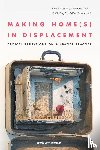Omschrijving
Making Home(s) in Displacement critically rethinks the relationship between home and displacement from a spatial, material, and architectural perspective. Making Home(s) in Displacement critically rethinks the relationship between home and displacement from a spatial, material, and architectural perspective. Recent scholarship in the social sciences has investigated how migrants and refugees create and reproduce home under new conditions, thereby unpacking the seemingly contradictory positions of making a home and overcoming its loss. Yet, making home(s) in displacement is also a spatial practice, one which intrinsically relates to the fabrication of the built environment worldwide.
Conceptually the book is divided along four spatial sites, referred to as camp, shelter, city, and house, which are approached with a multitude of perspectives ranging from urban planning and architecture to anthropology, geography, philosophy, gender studies, and urban history, all with a common focus on space and spatiality. By articulating everyday homemaking experiences of migrants and refugees as spatial practices in a variety of geopolitical and historical contexts, this edited volume adds a novel perspective to the existing interdisciplinary scholarship at the intersection of home and displacement. It equally intends to broaden the canon of architectural histories and theories by including migrants' and refugees' spatial agencies and place-making practices to its annals. By highlighting the political in the spatial, and vice versa, this volume sets out to decentralise and decolonise current definitions of home and displacement, striving for a more pluralistic outlook on the idea of home. Making Home(s) in Displacement critically rethinks the relationship between home and displacement from a spatial, material, and architectural perspective. Recent scholarship in the social sciences has investigated how migrants and refugees create and reproduce home under new conditions, thereby unpacking the seemingly contradictory positions of making a home and overcoming its loss. Yet, making home(s) in displacement is also a spatial practice, one which intrinsically relates to the fabrication of the built environment worldwide.
Conceptually the book is divided along four spatial sites, referred to as camp, shelter, city, and house, which are approached with a multitude of perspectives ranging from urban planning and architecture to anthropology, geography, philosophy, gender studies, and urban history, all with a common focus on space and spatiality. By articulating everyday homemaking experiences of migrants and refugees as spatial practices in a variety of geopolitical and historical contexts, this edited volume adds a novel perspective to the existing interdisciplinary scholarship at the intersection of home and displacement. It equally intends to broaden the canon of architectural histories and theories by including migrants' and refugees' spatial agencies and place-making practices to its annals. By highlighting the political in the spatial, and vice versa, this volume sets out to decentralise and decolonise current definitions of home and displacement, striving for a more pluralistic outlook on the idea of home. INTRODUCTION
Rethinking the Intersection of Home and Displacement from a Spatial Perspective
Luce Beeckmans, Ashika Singh & Alessandra Gola
PART 1 – CAMP
To Shelter in Place for a Time Beyond
Anooradha Iyer Siddiqi & Somayeh Chitchian
Towards Dwelling in Spaces of Inhospitality. A Phenomenological Exploration of Home in Nahr Al-Barid
Ashika Singh
Who/What Is Doing What? Dwelling and Homing Practices in Syrian Refugee Camps –The Kurdistan Region of Iraq
Layla Zibar, Nurhan Abujidi & Bruno de Meulder
In the Name of Belonging
Developing Sheikh Radwan for the Refugees in Gaza City, 1967-1982
Fatina Abreek-Zubiedat
PART 2 – SHELTER
At Home in the Centre? Spatial Appropriation and Horizons of Homemaking in Reception Facilities for Asylum Seekers
Paolo Boccagni
Bare Shelter. The Layered Spatial Politics of Inhabiting Displacement
Irit Katz
Refugee Shelters done Differently. Humanist Architecture of Socialist Yugoslavia
Aleksandar Staničić
Years in the Waiting Room. A feminist Ethnography of the Invisible Institutional Living Spaces of Forced Displacement
Maretha Dreyer
PART 3 – CITY
Gendering Displacement. Women Refugees and the Geographies of Dwelling in India
Romola Sanyal
Homing Displacements. Socio-Spatial Identities in Contemporary Urban Palestine
Alessandra Gola
Mediating between Formality and Informality. Refugee Housing as City-Making Activity in Refugee Crisis Athens
Aikaterini Antonopoulou
Making Home in Borgo Mezzanone. Dignity and Mafias in South Italy
Anna Di Giusto
PART 4 – HOUSE
News from the Living Room. Historiography and Immigrant Agency in Urban Housing in Berlin
Esra Akcan
The Nubian House. Displacement, Dispossession, and Resilience
Menna Agha
Trans-national Homes. From Nairobi to Cape Town
Huda Tayob
Static Displacement, Adaptive Domesticity. The Three Temporary Geographies of Firing Zone 918, Palestine
Wafa Butmeh
CODA
About the Displacement of Home
Hilde Heynen


